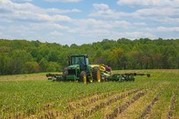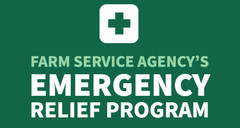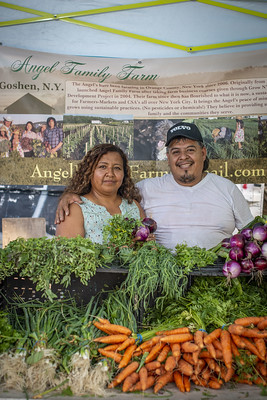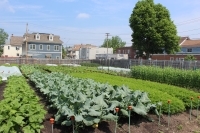|

The temperature is definitely rising this week around the state! Weather is always at the forefront of our minds. If severe weather affects your farm make sure you are reporting that to your local FSA office. Right now the county offices are in the final week of acreage reporting for most spring planted crops. If you haven’t been in contact with your local office yet, make sure you do so by this Friday, July 15th.
The deadline for nominating someone to for your County Committee Election is also approaching. Nominations are due by August 1st and you can nominate yourself or a neighbor. The election of responsible agricultural producers to FSA county committees is important to ALL farmers with large or small operations. It is crucial that every eligible producer take part in this election because county committees are a direct link between the farm community and the U.S. Department of Agriculture. Committee members are a critical component of the day-to-day operations of FSA. They work to make FSA agricultural programs serve the needs of local producers. Contact your local office to see what townships are up for election in your county this year.
Sincerely,
Jim Barber
|

Agricultural producers who have not yet completed their crop acreage reports after spring planting should make an appointment with their local Farm Service Agency (FSA) before the applicable deadline.
An acreage report documents a crop grown on a farm or ranch and its intended uses. Filing an accurate and timely acreage report for all crops and land uses, including failed acreage and prevented planted acreage, can prevent the loss of benefits.
How to File a Report
The following acreage reporting dates are applicable for New York:
June 15, 2022 - Onions
July 15, 2022 - Corn, Soybeans, Spring Planted Small Grains and most other crops including CRP and cover crops
August 15, 2022 - Cabbage & Beans
Service Center staff continue to work with agricultural producers via phone, email, and other digital tools. Because of the pandemic, some USDA Service Centers are open to limited visitors. Contact your FSA office to set up an in-person or phone appointment.
To file a crop acreage report, you will need to provide:
- Crop and crop type or variety.
- Intended use of the crop.
- Number of acres of the crop.
- Map with approximate boundaries for the crop.
- Planting date(s).
- Planting pattern, when applicable.
- Producer shares.
- Irrigation practice(s).
- Acreage prevented from planting, when applicable.
- Other information as required.
Acreage Reporting Details
The following exceptions apply to acreage reporting dates:
- If the crop has not been planted by the acreage reporting date, then the acreage must be reported no later than 15 calendar days after planting is completed.
- If a producer acquires additional acreage after the acreage reporting date, then the acreage must be reported no later than 30 calendar days after purchase or acquiring the lease. Appropriate documentation must be provided to the county office.
Producers should also report crop acreage they intended to plant, but due to natural disaster, were unable to plant. Prevented planting acreage must be reported on form CCC-576, Notice of Loss, no later than 15 calendar days after the final planting date as established by FSA and USDA’s Risk Management Agency.
Noninsured Crop Disaster Assistance Program (NAP) policy holders should note that the acreage reporting date for NAP-covered crops is the earlier of the dates listed above or 15 calendar days before grazing or harvesting of the crop begins.
More Information
For questions, please contact your local FSA office.
|

Agriculture Secretary Tom Vilsack announced that to date, agricultural producers have already received more than $4 billion through the Emergency Relief Program (ERP), representing approximately 67% of the more than $6 billion projected to be paid through this first phase of the program. The U.S. Department of Agriculture (USDA) mailed out pre-filled applications in late May to producers with crop insurance who suffered losses due to natural disasters in 2020 and 2021. Commodity and specialty crop producers have until July 22 to complete applications.
USDA is implementing ERP and ELRP in two phases, with the first phase utilizing existing claim data to provide relief expediently, and the second phase focusing on ensuring producers not covered by other programs receive assistance. For phase one, USDA used crop insurance and Noninsured Crop Disaster Assistance Program (NAP) claim data.
Both ERP and the previously announced Emergency Livestock Relief Program (ELRP) are funded by the Extending Government Funding and Delivering Emergency Assistance Act, which President Biden signed into law in 2021. The law provided $10 billion to help agricultural producers impacted by wildfires, droughts, hurricanes, winter storms and other eligible disasters experienced during calendar years 2020 and 2021, of which $750 million is committed to livestock producers who experienced losses to drought or wildfire in calendar year 2021. Eligible livestock producers received ELRP payments totaling more than $590 million since the program was rolled out in late March.
Pre-Filled Applications
Eligible producers with eligible crop insurance claims have received pre-filled applications, which included eligibility requirements and payment calculations. Producers received a separate application form for each program year in which they experienced an eligible loss.
Producers should check with the Farm Service Agency (FSA) at their local USDA Service Center to confirm eligibility and to ensure that all required farm program participation, adjusted gross income and conservation compliance forms are on file. Producers who have previously participated in FSA programs likely have these required forms already on file.
ERP provisions allow for a higher payment percentage for historically underserved producers, including beginning, limited resource, socially disadvantaged and military veteran producers. To qualify for the higher payment rate, individuals must have a Form CCC-860, Socially Disadvantaged, Limited Resource, Beginning and Veteran Farmer or Rancher Certification on file.
To receive a payment, producers must complete and submit their forms by the July 22 deadline. Once the completed ERP application for payment is submitted to and signed by the FSA, producers enrolled in direct deposit should look for their payment within three business days.
Additional Assistance through Phase One
FSA will be sending pre-filled applications for about 9,000 eligible producers with NAP coverage in mid-July.
The Federal crop insurance data used to populate ERP phase one pre-filled applications included claim data on file with USDA’s Risk Management Agency (RMA) as of May 2, 2022. At that time, claim data for the Supplemental Coverage Option (SCO), Enhanced Coverage Option (ECO), Stacked Income Protection Plan (STAX), Margin Protection Plan (MP) or Area Risk Protection Insurance (ARPI) were not complete, so crop/units including these coverage options were not included in the pre-filled ERP application form. In late summer 2022, updated claim information will be used to generate a second pre-filled application for those crop/units with eligible losses on file with RMA not included in the first mailing.
More Information
ERP covers losses to crops, trees, bushes and vines due to a qualifying natural disaster event in calendar years 2020 and 2021. Eligible crops include all crops for which crop insurance or NAP coverage was available, except for crops intended for grazing. Qualifying natural disaster events include wildfires, hurricanes, floods, derechos, excessive heat, winter storms, freeze (including a polar vortex), smoke exposure, excessive moisture, qualifying drought and related conditions.
All producers who receive ERP phase one payments are statutorily required to purchase crop insurance or NAP coverage where crop insurance is not available for the next two available crop years.
Producers should contact their local Service Center if they have questions. Additionally, other resources include:
The second phase of both ERP and ELRP will be aimed at filling gaps and providing assistance to producers who did not participate in or receive payments through the existing programs that are being leveraged for phase one implementation. Through proactive communication and outreach, USDA will keep producers and stakeholders informed as program details are made available.
|

The Noninsured Crop Disaster Assistance Program (NAP) provides financial assistance to you for crops that aren’t eligible for crop insurance to protect against lower yields or crops unable to be planted due to natural disasters including freeze, hail, excessive moisture, excessive wind or hurricanes, flood, excessive heat and qualifying drought (includes native grass for grazing), among others.
In order to participate, you must obtain NAP coverage for the crop year by the applicable deadline using form CCC-471 “Application for Coverage” and pay the service fee. Application closing dates vary by crop. Producers are also required to submit an acceptable crop acreage report. Additionally, NAP participants must provide:
- The quantity of all harvested production of the crop in which the producer held an interest during the crop year
- The disposition of the harvested crop, such as whether it is marketable, unmarketable, salvaged or used differently than intended
- Acceptable crop production records (when requested by FSA)
Producers who fail to report acreage and production information for NAP-covered crops could see reduced or zero NAP assistance. These reports are used to calculate the approved yield.
If your NAP-covered crops are affected by a natural disaster, notify your FSA office by completing Part B of form CCC-576 “Notice of Loss and Application for Payment.” This must be completed within 15 calendar days of the occurrence of the disaster or when losses become apparent or 15 days of the final harvest date. For hand-harvested crops and certain perishable crops, you must notify FSA within 72 hours of when a loss becomes apparent.
To receive benefits, you must also complete Parts D, E, F and G of the CCC-576 “Notice of Loss and Application for Payment” within 60 days of the last day of coverage for the crop year for any NAP covered crops. The CCC-576 requires acceptable appraisal information. Producers must provide evidence of production and note whether the crop was marketable, unmarketable, salvaged or used differently than intended.
Eligible crops must be commercially produced agricultural commodities for which crop insurance is not available, including perennial grass forage and grazing crops, fruits, vegetables, mushrooms, floriculture, ornamental nursery, aquaculture, turf grass, ginseng, honey, syrup, bioenergy, and industrial crops.
For more information on NAP, contact your local USDA Service Center or visit fsa.usda.gov/nap.
|

Agriculture Secretary Tom Vilsack announced that the U.S. Department of Agriculture (USDA) plans to provide up to $200 million in assistance for specialty crop producers who incur eligible on-farm food safety program expenses to obtain or renew a food safety certification in calendar years 2022 or 2023. USDA’s new Food Safety Certification for Specialty Crops (FSCSC) program will help to offset costs for specialty crop producers to comply with regulatory requirements and market-driven food safety certification requirements, which is part of USDA’s broader effort to transform the food system to create a more level playing field for small and medium producers and a more balanced, equitable economy for everyone working in food and agriculture.
Specialty crop operations can apply for assistance for eligible expenses related to a 2022 food safety certificate issued on or after June 21, 2022, beginning June 27, 2022. USDA is delivering FSCSC to provide critical assistance for specialty crop operations, with an emphasis on equity in program delivery while building on lessons learned from the COVID-19 pandemic and supply chain disruptions. Vilsack made the announcement from Hollis, N.H., where he toured a local, family-owned farm and highlighted USDA’s efforts to help reduce costs for farmers and support local economies by providing significant funding to cut regulatory costs and increase market opportunities for farmers in New Hampshire and across the nation.
Program Details
FSCSC will assist specialty crop operations that incurred eligible on-farm food safety certification and related expenses related to obtaining or renewing a food safety certification in calendar years 2022 and 2023. For each year, FSCSC covers a percentage of the specialty crop operation’s cost of obtaining or renewing their certification, as well as a portion of their related expenses.
To be eligible for FSCSC, the applicant must be a specialty crop operation; meet the definition of a small business or very small business; and have paid eligible expenses related to the 2022 (issued on or after June 21, 2022) or 2023 certification.
Specialty crop operations may receive assistance for the following costs:
- Developing a food safety plan for first-time food safety certification.
- Maintaining or updating an existing food safety plan.
- Food safety certification.
- Certification upload fees.
- Microbiological testing for products, soil amendments and water.
FSCSC payments are calculated separately for each category of eligible costs. A higher payment rate has been set for socially disadvantaged, limited resource, beginning and veteran farmers and ranchers. Details about the payment rates and limitations can be found at farmers.gov/food-safety.
Applying for Assistance
The FSCSC application period for 2022 is June 27, 2022, through January 31, 2023, and the application period for 2023 will be announced at a later date. FSA will issue payments at the time of application approval for 2022 and after the application period ends for 2023. If calculated payments exceed the amount of available funding, payments will be prorated.
Interested specialty crop producers can apply by completing the FSA-888, Food Safety Certification for Specialty Crops Program (FSCSC) application. The application, along with other required documents, can be submitted to the FSA office at any USDA Service Center nationwide by mail, fax, hand delivery or via electronic means.
Producers can visit farmers.gov/food-safety for additional program details, eligibility information and forms needed to apply.
|
Each state has a dedicated Beginning Farmer and Rancher (BFR) team to help producers with less than 10 years’ experience learn about available programs and services. Lynnette Wright is the State Coordinator in New York. Lynnette is the team lead and will answer questions from farmers and ranchers. She can be reached at lynnette.wright@usda.gov or 315-477-6309.

Options Help More Beginning, Small and Urban Producers Gain Access to Credit
Producers can apply for a streamlined version of USDA guaranteed loans, which are tailored for smaller scale farms and urban producers EZ Guarantee Loans use a simplified application process to help beginning, small, underserved, and family farmers and ranchers apply for loans of up to $100,000 from USDA-approved lenders to purchase farmland or finance agricultural operations.
A new category of lenders will join traditional lenders, such as banks and credit unions, in offering USDA EZ Guarantee Loans. Microlenders, which include Community Development Financial Institutions and Rural Rehabilitation Corporations, will be able to offer their customers up to $50,000 of EZ Guaranteed Loans, helping to reach urban areas and underserved producers. Banks, credit unions and other traditional USDA-approved lenders, can offer customers up to $100,000 to help with agricultural operation costs.
EZ Guarantee Loans offer low interest rates and terms up to seven years for financing operating expenses and 40 years for financing the purchase of farm real estate. USDA-approved lenders can issue these loans with the Farm Service Agency (FSA) guaranteeing the loan up to 95 percent.
For more information about the available types of FSA farm loans, contact your local USDA Service Center or visit fsa.usda.gov/farmloans.
|

The Farm Service Agency (FSA) is accepting offers for specific conservation practices under the Conservation Reserve Program (CRP) Continuous Signup.
In exchange for a yearly rental payment, farmers enrolled in the program agree to remove environmentally sensitive land from agricultural production and to plant species that will improve environmental health and quality. The program’s long-term goal is to re-establish valuable land cover to improve water quality, prevent soil erosion, and reduce loss of wildlife habitat. Contracts for land enrolled in CRP are 10-15 years in length.
Under continuous CRP signup, environmentally sensitive land devoted to certain conservation practices can be enrolled in CRP at any time. Offers for continuous enrollment are not subject to competitive bidding during specific periods. Instead they are automatically accepted provided the land and producer meet certain eligibility requirements and the enrollment levels do not exceed the statutory cap.
For more information, including a list of acceptable practices, contact your local USDA Service Center or visit fsa.usda.gov/crp.
|
The USDA Farm Service Agency’s (FSA) Direct Farm Ownership loans are a resource to help farmers and ranchers become owner-operators of family farms, improve and expand current operations, increase agricultural productivity, and assist with land tenure to save farmland for future generations.
There are three types of Direct Farm Ownership Loans: regular, down payment and joint financing. FSA also offers a Direct Farm Ownership Microloan option for smaller financial needs up to $50,000.
Direct Farm Ownership Loans can be used to construct, purchase or improve farm dwellings, service buildings or other facilities, and to make improvements essential to an operation.
Applicants must provide FSA with an estimate of the total cost of all planned development that completely describe the work, prior to loan approval and must show proof of sufficient funds to pay for the total cost of all planned development at or before loan closing. In some instances, applicants may be asked to provide certified plans, specifications or contract documents. The applicant cannot incur any debts for materials or labor or make any expenditures for development purposes prior to loan closing with the expectation of being reimbursed from FSA funds.
Construction and development work may be performed either by the contract method or the borrower method. Under the contract method, construction and development contractors perform work according to a written contract with the applicant or borrower. If applying for a direct loan to finance a construction project, the applicant must obtain a surety bond that guarantees both payment and performance in the amount of the construction contract from a construction contractor.
A surety bond is required when a contract exceeds $100,000. An authorized agency official determines that a surety bond appears advisable to protect the borrower against default of the contractor or a contract provides for partial payments in excess of the amount of 60 percent of the value of the work in place.
Under the borrower method, the applicant or borrower will perform the construction and development work. The borrower method may only be used when the authorized agency official determines, based on information from the applicant, that the applicant possesses or arranges to obtain the necessary skill and managerial ability to complete the work satisfactorily and that such work will not interfere with the applicant’s farming operation or work schedule.
Potential applicants should visit with FSA early in the initial project planning process to ensure environmental compliance.
For more eligibility requirements and information about FSA Loan programs, contact your local USDA Service Center or visit fsa.usda.gov.

The National Environmental Policy Act (NEPA) requires Federal agencies to consider all potential environmental impacts for federally funded projects before the project is approved.
For all Farm Service Agency (FSA) programs, an environmental review must be completed before actions are approved, such as site preparation or ground disturbance. These programs include, but are not limited to, the Emergency Conservation Program (ECP), Farm Storage Facility Loan (FSFL) program and farm loans. If project implementation begins before FSA has completed an environmental review, the request will be denied. Although there are exceptions regarding the Stafford Act and emergencies, it’s important to wait until you receive written approval of your project proposal before starting any actions.
Applications cannot be approved until FSA has copies of all permits and plans. Contact your local FSA office early in your planning process to determine what level of environmental review is required for your program application so that it can be completed timely.
|
Farmers and other producers and growers now have a one-stop shop to help ensure they are treated fairly. The new farmerfairness.gov portal developed jointly by the U.S. Department of Agriculture (USDA) and Department of Justice (DOJ) allows you to report potential violations of livestock and poultry antitrust laws, including the Packers and Stockyards Act.
Agriculture Secretary Tom Vilsack recently expressed concern that producers across the country have for too long faced a marketplace that benefits a few large companies over the farmers and ranchers who grow and raise our food.
For example, ranchers received more than 60 cents of every dollar a consumer spent on beef 50 years ago, compared to approximately 39 cents today. Hog farmers fared worse over the past 50 years, as their share of the consumer dollar fell from between 40 to 60 cents 50 years ago to approximately 19 cents today.
In order to assure economic opportunity and fairness for all, this portal makes it easy for farmers and ranchers to register a complaint or tip and provide details that would aid an investigation.
Who may submit a complaint or tip?
Anyone who suspects a violation of Federal law governing fair and competitive marketing and contract growing of livestock and poultry, including the Packers and Stockyards Act.
What information should I provide?
Those reporting potential violations of the Packers and Stockyards Act and other competition laws via the online portal are asked to submit the following information:
- The names of companies, individuals, or organizations that are involved,
- A description of any possible violations of the Packers and Stockyards Act or other federal antitrust laws,
- Examples of the conduct that may violate one or more of these laws,
- Any other relevant details about the violation, and
- The names of companies, individuals, or organizations that may be harmed by the alleged violation and how they are harmed.
What is the process following submission of a complaint or tip?
Complaints and tips will go through a preliminary review by USDA Packers and Stockyards Division staff and Department of Justice staff. If a complaint raises sufficient concern under the Packers and Stockyards Act or antitrust laws, it will be selected for further investigation by the appropriate agency. This action may lead to the opening of a formal investigation.
USDA or DOJ staff will only contact complainants if additional information is needed.
Will my confidentiality be protected?
Both USDA and DOJ will protect the confidentiality of the complainants to the fullest extent possible under the law. For any information provided, DOJ and USDA will follow their respective Privacy and Confidentiality Policies found at: DOJ Confidentiality and USDA Privacy. Packers and Stockyards regulations regarding confidentiality also apply: PSD Confidentiality. DOJ and USDA commit to supporting relevant whistleblower protections, including newly applicable protections for criminal antitrust complainants against unlawful retaliation.
To submit an anonymous complaint or tip, complainants or tippers should provide appropriate details but not enter their names or contact information. Neither USDA nor DOJ will be able to contact anonymous complainants or tips to obtain additional information that might be needed to evaluate your complaint tip, or to engage in future correspondence regarding your complaint or tip.
Farmers, ranchers, and other producers and growers deserve the benefits of fair and competitive markets for their products and services. This portal is an additional tool to support and protect these individuals who are vital to agriculture and our food supply.
|